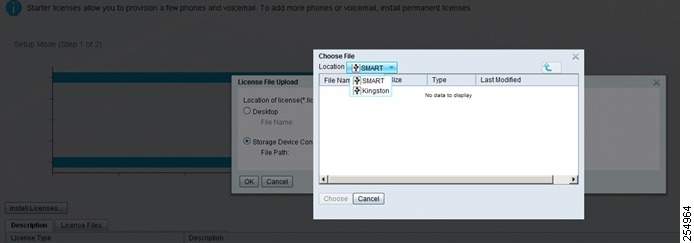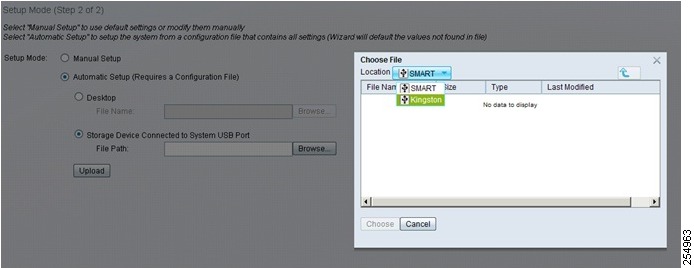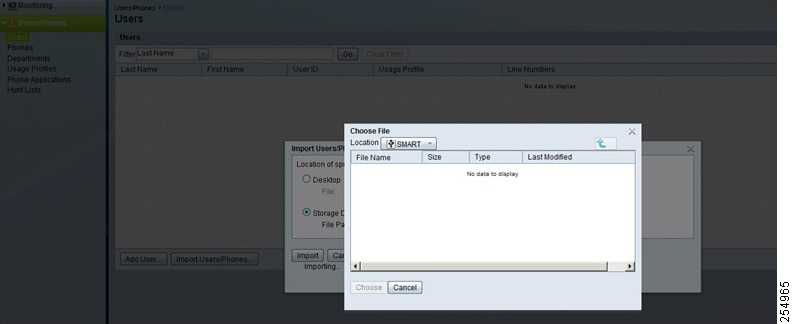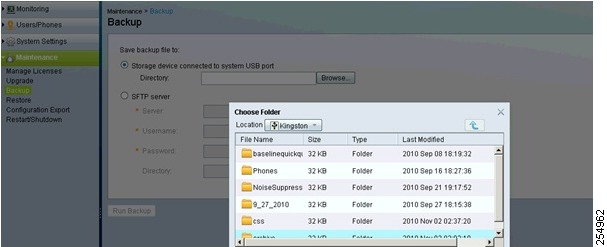 Feedback Feedback
|
Table Of Contents
Release Notes for Cisco Unified Communications Manager Business Edition 3000 Release 8.6(2)
Obtaining Files for Cisco Unified Communications Manager Business Edition 3000 on www.cisco.com
Cisco Unified Communications Manager Business Edition 3000 and USB Usage
CSCtj88176 Default to Internal USB Key Requires User to Select External USB Key
CD/DVD USB Drive Support for Cisco Unified Communications Manager Business Edition 3000 8.6(2)
Telnet Limitation for Cisco Unified SIP Phone 3905
Call Pickup Feature Limitation
CSCtq34429 FTS spreadsheet upload failed with error message though fills all details
Open Caveats for Cisco Unified Communications Manager Release 8.6(2)
CSCto58908—Alarm on Health Summary when Channels Are not Configured on PSTN
CSCts02379—Unable to See Troubleshooting Information when Fan Speed Goes Out of Threshold
Obtaining Documentation and Submitting a Service Request
Release Notes for Cisco Unified Communications Manager Business Edition 3000 Release 8.6(2)
September 19, 2011Contents
This document contains information on the following topics:
•
Obtaining Documentation and Submitting a Service Request
Introduction
These release notes are based on the 8.6.2.10000-29 software version of Cisco Unified Communications Manager Business Edition 3000 for Release 8.6(2). The Cisco Unified Communications Manager Business Edition 3000 server comes preinstalled with Cisco Unified Communications Manager Business Edition 3000, and is provided as an appliance.
Cisco Unified Communications Manager Business Edition 3000, a system under the Cisco Unified Communications family of products, provides an IP telephony solution that enables the following:
•
Easy setup of deployments
•
Easy provisioning of users, phones, lines, and phone features
•
Easy monitoring and troubleshooting
•
Easy maintenance of your system (for example, simplified backups and restores)
The Cisco Unified Communications Manager Business Edition 3000 software is preinstalled in your system so that you do not have to perform a software installation to get your server up and running. Deployment of the Cisco Unified Communications Manager Business Edition 3000 server, phones, and the gateway across an IP network provides a distributed virtual-telephony network. Quality of service is maintained across constricted WAN links, the Internet, or VPN connections.
Your Cisco Unified Communications Manager Business Edition 3000 system is designed to support up to 300 users and 400 phones. Supplementary and enhanced services such as hold, transfer, forward, conference, multiple-line appearances, speed dials, last-number redial, and other features extend to the phones.
Web-browser interfaces allow configuration of the system. These interfaces also provide access to online help.
For more complete information about Cisco Unified Communications Manager Business Edition 3000, see the Administration Guide for Cisco Unified Communications Manager Business Edition 3000 at the following URL:
http://www.cisco.com/en/US/products/ps11370/prod_maintenance_guides_list.html
System Requirements
For minimum requirements for products that work with Cisco Unified Communications Manager Business Edition 3000, see the Software Compatibility Matrix for Cisco Unified Communications Manager Business Edition 3000, which you can obtain at the following URL:
http://www.cisco.com/en/US/docs/voice_ip_comm/cucmbe3k/compat/3kcompmtx.html
New and Changed Information
For a list of documents to review before you configure the Cisco Unified Communications Manager Business Edition 3000 system, see the "Related Documentation" section.
Related Documentation
You can view documentation that supports this release of Cisco Unified Communications Manager Business Edition 3000 at http://www.cisco.com/en/US/products/ps11370/tsd_products_support_series_home.html.
Review the following documentation before you configure Cisco Unified Communications Manager Business Edition 3000 Release 8.6(2):
•
The Software Compatibility Matrix for Cisco Unified Communications Manager Business Edition 3000, which lists the minimum software requirements for the products that are supported with Cisco Unified Communications Manager Business Edition 3000.
•
The Cisco Unified IP Phone 6900 Firmware Upgrade from 8.5 (x) to 9.2(1), which provides guidelines and best practices on how to upgrade Cisco Unified IP Phones 6921, 6941, and 6961 from Firmware Version 8.5(x) SCCP Unsigned to Version 9.2(1) or current shipping version so they can successfully register on a Cisco Unified Communications Manager Business Edition 3000 server.
•
The Administration Guide for Cisco Unified Communications Manager Business Edition 3000, which provides important information on how to configure and troubleshoot your system. This document is available in English, Mandarin, German, Italian, Portuguese, Spanish, and French.
•
The Cisco MCS 7890-C1 Unified Communications Manager Business Edition 3000 Appliance User Guide, which provides procedural information for users who are operating the Cisco MCS 7890-C1.
Note
Obtain the preceding documents at
http://www.cisco.com/en/US/products/ps11370/tsd_products_support_series_home.html.
For the GUIs, online help is displayed in English, Mandarin, German, Italian, Portuguese, Spanish, or French, depending on the country-pack preference that you configure. Field descriptions are displayed for the settings in the GUIs. Use the online help in conjunction with the Administration Guide for Cisco Unified Communications Manager Business Edition 3000, which includes more information on Cisco Unified Communications Manager Business Edition 3000.
Important Notes
Review the following important information before you configure Cisco Unified Communications Manager Business Edition 3000. See the following sections:
•
Obtaining Files for Cisco Unified Communications Manager Business Edition 3000 on www.cisco.com
•
Cisco Unified Communications Manager Business Edition 3000 and USB Usage
•
CSCtj88176 Default to Internal USB Key Requires User to Select External USB Key
•
CD/DVD USB Drive Support for Cisco Unified Communications Manager Business Edition 3000 8.6(2)
•
Telnet Limitation for Cisco Unified SIP Phone 3905
•
Call Pickup Feature Limitation
•
CSCtq34429 FTS spreadsheet upload failed with error message though fills all details
Obtaining Files for Cisco Unified Communications Manager Business Edition 3000 on www.cisco.com
Table 1 lists where you can obtain important files that are used with Cisco Unified Communications Manager Business Edition 3000. For example, Table 1 lists where to go to get the Cisco-provided .xls data configuration file, the Cisco-provided country packs, the upgrade files, the Cisco User Connect licenses, and other important files. Before you use these files, review the Administration Guide for Cisco Unified Communications Manager Business Edition 3000.
Table 1 Where to Obtain Files for Cisco Unified Communications Manager Business Edition 3000
Related Documentation
Referenced to configure the system
See the "Related Documentation" section.
Cisco User Connect licensing site
Needed to order Cisco User Connect licenses
Go to the following URL to download the various files that you use with Cisco Unified Communications Manager Business Edition 3000:
http://www.cisco.com/cisco/software/navigator.html?mdfid=283661240&flowid=26421Cisco-provided .xls data configuration file—
cuba_install.zip (containing cuba_install.xls)Needed to enter configuration data for automatic setup
Network Configuration Signature file—
configure.xmlRequired for setting up server to access your network
Upgrade files
Required for upgrading software, firmware, locale updates, and dial plan updates
Cisco-provided country packs
Needed to install localized dial plans and locales (tones and language)
Cisco Diagnostics USB Signature file— diagnose.xml
Needed to troubleshoot when you cannot access the GUIs
Answer file—
platformConfig.xmlRequired to reimage the server (for troubleshooting only when your technical support team advises that you reimage the server)
All installation parameters are provided with this file and cannot be modified.
Default username: admin
Password: BE-3000
Cisco Unified Communications Manager Business Edition 3000 and USB Usage
For many tasks that you can perform in Cisco Unified Communications Manager Business Edition 3000, you can use a USB key or USB hard disk if the file exists on the USB device. Instead of using a USB device, you can use the PC desktop or SFTP server for many of these tasks, as described in the Administration Guide for Cisco Unified Communications Manager Business Edition 3000. This section only describes USB usage for these tasks; it does not describe the SFTP server or PC desktop options.
CautionYou can purchase the USB devices at any retailer. Cisco does not provide support for the USB devices through the Cisco Technical Assistance Center (TAC). If you have issues with the USB hardware, contact the manufacturer of the USB device or the retailer where you purchased the device.
Before you use a USB key, you must download the Network Configuration Signature file (configure.xml) from http://www.cisco.com/cisco/software/navigator.html?mdfid=283661240&flowid=26421, edit the file with valid network information (such as IP address, subnet mask, and gateway configuration), and save the updated copy in the USB key.
Cisco recommends two USB keys: one for diagnostics and one for recovery (network configuration). The USB key that you use for recovery does not modify the existing network setting of your machine. When the network configuration USB key is inserted into the system, temporary network access is established, allowing you to access the Cisco Unified Communications Manager Business Edition 3000 Administrative Interface. This temporary network access is automatically disabled if the machine is restarted.
When you modify the network configuration USB key, open the temporary IP address in your browser; then, log in to the Cisco Unified Communications Manager Business Edition 3000 Administrative Interface and modify the network settings to reflect the changes that you made in the temporary network interface so that the modifications are permanent.
Note
Cisco recommends that you use two dedicated USB keys for network configuration (recovery) and diagnostics. You should copy the Network Configuration Signature file (configure.xml) to the network configuration USB key and the Diagnostics Signature file (diagnose.xml) to the Diagnostics USB key.
Phone Firmware Upgrades
Cisco Unified IP Phone 6900 Series is compatible with Cisco Unified Communications Manager Business Edition 3000. Cisco Unified IP Phone 6900 Series with 9.0(2) SCCP phone firmware automatically upgrades to 9.2(1) SIP firmware.
If you have 8.5 SCCP firmware on 6900 Series phones, see the Cisco Unified IP Phone 6900 Firmware Upgrade from 8.5 (x) to 9.2(1) Troubleshooting TechNote that describes how to upgrade to 9.2(1) SIP or a later firmware version at the following URL:
http://www.cisco.com/en/US/products/ps11370/products_tech_note09186a0080b82100.shtmlCSCtj88176 Default to Internal USB Key Requires User to Select External USB Key
Note
The following procedure is applicable only to the MCS 7816-I5 server. It does not apply to the
MCS 7890-C1.
Be aware that the following operations display the internal USB key "SMART" by default during the USB key process. For each scenario, you must select the external USB key for each of these components to work properly.
•
License File
•
Spreadsheet (for manual setup mode)
•
Import Users/Phones
•
Backup
•
USB Country Pack
Figure 1 through Figure 4 show examples in which the internal USB key "SMART" is selected by default. In these examples, the user selects the external USB key "Kingston."
Note
The name of the external USB key depends on the type of USB key that you have.
Figure 1 Internal USB Key Displayed While License Is Copied
Figure 1 shows that by default the internal USB key is displayed while the license file is copied. Select the external USB key to copy the license file.
Figure 2 Internal USB Key Displayed While Spreadsheet Is Copied
Figure 2 shows that by default the internal USB key is displayed while the configuration spreadsheet is copied. Select the external USB key to copy the configuration spreadsheet.
Figure 3 Internal USB Key Displayed for Users/Phones Operation
Figure 3 shows that by default the internal USB key is displayed for the Users/Phones operation. Select the external USB key to copy the Users/Phones information.
Figure 4 Internal USB Key Displayed During Backup Operation
Figure 4 shows that by default the internal USB key is displayed during a backup operation. Select the external USB key for a backup operation.
CD/DVD USB Drive Support for Cisco Unified Communications Manager Business Edition 3000 8.6(2)
The Cisco MCS 7890-C1 requires an external USB 2.0 CD/DVD drive for reimaging or performing a server recovery. The following drives have been tested and are compatible with the Cisco MCS 7890-C1:
•
Sony DRX-530UL
•
Iomega CDDVD522416EC3
•
Samsung DRX-S70
•
Sony DRX-840
You can use other USB CD/DVD drive models, provided they meet the following specifications:
•
Up to 52x24x52x write/rewrite/read CD speeds
•
Up to 16x DVD-ROM read speeds
•
USB 2.0 interface
•
External power supply
•
Support Dual-Layer DVD
Telnet Limitation for Cisco Unified SIP Phone 3905
Cisco Unified Communications Manager Business Edition 3000 does not support the use of Telnet to connect to the Cisco Unified SIP Phone 3905 while troubleshooting and during phone maintenance.
Call Pickup Feature Limitation
Call Pickup allows you to answer a call that is ringing on a coworker's phone by redirecting the call to your phone. Cisco Unified Communications Manager Business Edition 3000 supports only the Directed Call Pickup feature on Cisco Unified SIP Phone 3905.
CSCtq34429 FTS spreadsheet upload failed with error message though fills all details
When you use the data configuration file, which is a Cisco-provided .xls spreadsheet template, for automatic setup during the Cisco Unified Communications Manager Business Edition 3000 First Time Setup Wizard, the system automatically uses the default values for settings that are not mandatory in the file. In rare cases, the spreadsheet upload fails without showing any error notifications. The spreadsheet upload failure can have various causes—for example, incorrect configuration settings in multiple FTS pages.
Note
Cisco Unified Communications Manager Business Edition 3000 does not check the integrity of the configuration data until after the Cisco-provided .xls data configuration file is inserted into the system.
For the automatic setup to succeed, you must review and update the settings in the FTS file and try uploading the spreadsheet again. The following are a few examples of FTS settings that can get configured incorrectly:
•
Network tab—Invalid inputs for IP Address(System), IP Address(Media Resource), Subnet Mask, or Default Gateway.
•
PSTN Gateway tab—Invalid inputs for Line Coding and Framing—One of these or both the ports (Port 0/0/0 and Port 1).
•
Dial Plan tab—Invalid inputs for Operator Dial Code, Outside Dial Code, Feature Dial Code, or Interdigit Timeout.
•
Sites tab—Invalid Local Area Codes for Central Sites. Make sure that you add appropriate values for Additional Emergency Services and Emergency Location ID Numbers; else, keep these fields empty.
CSCts28780 No MWI indication on Webex Connect softphone (Cisco Unified Communications Manager Business Edition 3000)
Cisco Unified Communications Manager Business Edition 3000 supports the Cisco UC Integration for Cisco WebEx Connect Administration Tool, which enables administrators to monitor, manage, control, and enhance user access to Cisco WebEx Connect.
Note
Cisco Unified Communications Manager Business Edition 3000 does not support the Message Waiting Indicator (MWI) feature that notifies the user when a new voice message is delivered.
Caveats
The following sections contain information on how to obtain the latest resolved caveat information and latest open caveat information for bugs of severity levels 1, 2, and 3.
Caveats describe unexpected behavior for Cisco Unified Communications Manager Business Edition 3000. Severity 1 caveats represent the most serious caveats, severity 2 caveats represent less serious caveats, and severity 3 caveats represent moderate caveats.
See the following sections:
Using Bug Toolkit
You can search for the latest resolved and open caveats by using the Cisco Software Bug Toolkit. To access the Cisco Software Bug Toolkit, you need the following items:
•
Internet connection
•
Web browser
•
Cisco.com user ID and password
To use the Cisco Software Bug Toolkit, perform the following procedure:
Procedure
Step 1
Access the Cisco Software Bug Toolkit at http://tools.cisco.com/Support/BugToolKit.
Step 2
Log in with your Cisco.com user ID and password.
Step 3
If you are looking for information about a specific problem, enter the bug ID number in the Search for Bug ID field, and click Go.
Tip
Click Help on the Bug Toolkit page for information about how to search for bugs, create saved searches, and create bug groups.
Resolved Caveats
These release notes do not list the resolved caveats because Cisco Software Bug Toolkit provides the latest list of resolved and open caveats. You can find the latest resolved caveat information by using the Cisco Software Bug Toolkit, as described in the "Using Bug Toolkit" section.
Open Caveats
These release notes list the caveats that are open as of September 14, 2011. These release notes contain descriptions of the following:
•
All severity level 1 or 2 caveats
•
Significant severity level 3 caveats
Note
Because caveat status continually changes, be aware that the Table 3, "Open Caveats for Cisco Unified Communications Manager Business Edition 3000 Release 8.6(2) as of September 14, 2011" reflects a snapshot of the caveats that were open at the time this report was compiled. For an updated view of open caveats, access Bug Toolkit and follow the instructions described in the "Using Bug Toolkit" section.
Table 3 Open Caveats for Cisco Unified Communications Manager Business Edition 3000 Release 8.6(2) as of September 14, 2011
Open Caveats for Cisco Unified Communications Manager Release 8.6(2)
Open caveats for Unified CM Release 8.6(2) also describe possible unexpected behaviors in the Cisco Unified Communications Manager Business Edition 3000. So, all the open caveats that apply to the Unified CM apply to the Cisco Unified Communications Manager Business Edition 3000 as well.
For information on the list of open caveats for Unified CM, see the release notes for Cisco Unified Communications Manager at
http://www.cisco.com/en/US/docs/voice_ip_comm/cucm/rel_notes/8_6_2/cucm-rel_notes-862.html
Documentation Updates
The Documentation Updates section contains information on errors, omissions, and changes for the Administration Guide for Cisco Unified Communications Manager Business Edition 3000 and online help. See the following sections:
•
CSCto58908—Alarm on Health Summary when Channels Are not Configured on PSTN
•
CSCts02379—Unable to See Troubleshooting Information when Fan Speed Goes Out of Threshold
CSCto58908—Alarm on Health Summary when Channels Are not Configured on PSTN
The English, Mandarin, German, Italian, Portuguese, Spanish, and French online help for Cisco Unified Communications Manager Business Edition 3000 Administrative Interface does not include the following troubleshooting information when the system is nearing maximum call capacity.
Description
An alarm is generated when PSTN calls utilization nears 100%. PSTN calls will not be established after utilization reaches 100% when:
•
All the channels are busy
•
The PSTN configuration settings are incorrect
•
One or more channels are not functioning properly
•
There is an error in the service provider settings
Resolution
Perform any of the following actions:
•
Review the reports for high call volume on the Call Detail Reports page (Monitoring > Call Detail Reports).
•
Reduce the number of inbound and outbound calls.
•
Make sure that you select the proper channel selection order. For example, if you lease channels 1 to 15, you must have the channel selection order as top-down. If you did not lease the entire PRI span from the service provider, enter only the partial channel range that is available.
If this problem persists, contact your technical support team; for example, contact your Value Added Reseller (VAR), or if you are the Value Added Reseller, contact the Cisco Technical Assistance Center (TAC).
CSCts02379—Unable to See Troubleshooting Information when Fan Speed Goes Out of Threshold
The system fan is not operating properly and the system must be powered down and then restarted.
Description
The system fan is not operating properly.
Resolution
Restart the server. (Select Maintenance > Restart/Shutdown.)
Obtaining Documentation and Submitting a Service Request
For information on obtaining documentation, submitting a service request, and gathering additional information, see the monthly What's New in Cisco Product Documentation, which also lists all new and revised Cisco technical documentation, at
http://www.cisco.com/en/US/docs/general/whatsnew/whatsnew.html
Subscribe to the What's New in Cisco Product Documentation as a Really Simple Syndication (RSS) feed and set content to be delivered directly to your desktop by using a reader application. Be aware that the RSS feeds are a free service, and Cisco currently supports RSS Version 2.0.
Cisco and the Cisco Logo are trademarks of Cisco Systems, Inc. and/or its affiliates in the U.S. and other countries. A listing of Cisco's trademarks can be found at www.cisco.com/go/trademarks. Third party trademarks mentioned are the property of their respective owners. The use of the word partner does not imply a partnership relationship between Cisco and any other company. (1005R)
Any Internet Protocol (IP) addresses and phone numbers used in this document are not intended to be actual addresses and phone numbers. Any examples, command display output, network topology diagrams, and other figures included in the document are shown for illustrative purposes only. Any use of actual IP addresses or phone numbers in illustrative content is unintentional and coincidental.
© 2011 Cisco Systems, Inc. All rights reserved






